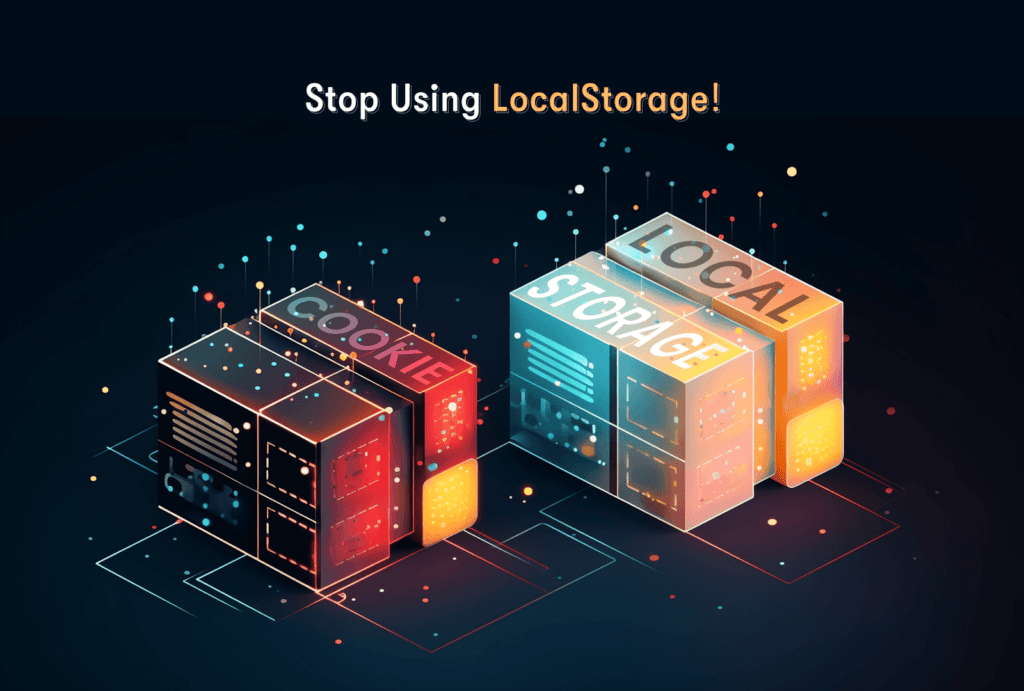Local storage has been a commonly used feature in web development for storing data on the client-side. It allows developers to save data locally in the user’s browser, providing a convenient way to persist information across sessions. However, relying solely on localStorage for sensitive information can pose serious security risks.
In today’s digital landscape, data security is incredibly important. Storing sensitive information, like user credentials or personal details, in localStorage exposes it to potential attacks. One such vulnerability is cross-site scripting (XSS), where an attacker can inject harmful scripts into a website and gain unauthorized access to localStorage data.
To demonstrate the dangers of localStorage, let’s look at a real-life example. Imagine an online store that uses localStorage to store customers’ credit card information. If a hacker exploits an XSS vulnerability on that website, they can easily access and steal the saved credit card data.
Such security breaches have serious consequences, not just for the affected users but also for the reputation and trustworthiness of the application. That’s why it’s crucial to prioritize data storage security in web applications and explore other options that offer better protection against these vulnerabilities.
In the following sections, we will discuss alternative approaches that address the limitations and security risks of localStorage:
- Server-side sessions with cookies for sensitive data storage
- IndexedDB as a versatile client-side database option for non-sensitive data
- Combining IndexedDB with the Cache API to enhance offline capabilities
The Risks of Using localStorage for Sensitive Information
When it comes to storing sensitive information in web applications, the use of localStorage poses significant security risks. Here’s why:
- Vulnerability to Cross-Site Scripting (XSS): Data stored in localStorage is susceptible to attacks such as cross-site scripting (XSS). This occurs when an attacker injects malicious scripts into a web application, allowing them to access and manipulate the data stored in localStorage. As a result, sensitive information such as user credentials or personal details becomes compromised.
- Real-World Security Breaches: Numerous real-world examples highlight the risks associated with relying on localStorage for sensitive data storage. Incidents of XSS attacks targeting localStorage have led to unauthorized access to user information, financial data theft, and privacy breaches. These security incidents underscore the inherent vulnerabilities of using localStorage for confidential data storage.
By understanding these risks and their potential impact, developers can recognize the importance of adopting secure alternatives for storing sensitive information in web applications.
1. Server-side Sessions with Cookies
Server-side sessions with cookies offer a robust alternative to localStorage for sensitive data storage in web applications. By shifting the storage of sensitive user information from the client side to the server side, developers can mitigate the risks associated with client-side storage mechanisms.
Benefits of Server-side Sessions with Cookies
1. Preventing direct access to sensitive data by storing it on the server side.
By storing sensitive data on the server side, it cannot be directly accessed by unauthorized entities. This is because the information is kept within the secure environment of the server, making it harder for attackers to compromise.
2. Ensuring better control over session management and expiration through unique session identifiers stored in cookies.
With server-side sessions, web applications can have more control over how sessions are managed and when they expire. This is done through the use of unique session identifiers stored in cookies, which act as a reference point for identifying and tracking user sessions.
Implementing server-side sessions with cookies aligns with best practices for safeguarding sensitive user data, offering a more secure and controlled environment for managing session-related information.
Recommended Approach for Protecting User Details in Server-side Sessions
Brief Introduction to Server-Side Sessions
Server-side sessions involve storing user session data on the server instead of the client side. This ensures that sensitive information is not exposed to potential security threats associated with client-side storage.
Utilization of Cookies for Secure Data Storage
Cookies are commonly used to manage session identifiers and store session-related data on the server side. By utilizing cookies in conjunction with server-side sessions, developers can enhance the security of sensitive user details.
Benefits of Server-Side Sessions and Cookies
The use of server-side sessions with cookies provides an effective alternative to localStorage for storing sensitive data. It offers enhanced security by preventing direct access to critical information and enables better control over session management and expiration.
Securing Server-Side Sessions
Implementing encryption and secure protocols such as HTTPS is essential for protecting the confidentiality and integrity of session cookies. By adhering to best practices for securing server-side sessions, developers can further mitigate potential vulnerabilities and ensure robust data protection.
2. IndexedDB: A Versatile Browser Storage Option
IndexedDB is a client-side database that provides a powerful alternative to localStorage for non-sensitive data storage in web applications. It offers several benefits and advantages over localStorage, making it an ideal choice for handling larger amounts of structured data.
Brief Overview of IndexedDB
IndexedDB is a JavaScript-based database that allows developers to store and retrieve large volumes of data on the client-side. It provides a more robust and flexible solution compared to localStorage, which is primarily designed for storing small amounts of data.
IndexedDB uses an object-oriented approach to store data, allowing you to work with complex data structures like objects and arrays natively. This makes it easier to organize and manipulate your data, especially when dealing with large datasets.
Comparison to localStorage
While localStorage is suitable for storing small amounts of key-value pairs, it becomes less efficient as the amount of data increases. In contrast, IndexedDB excels at handling larger amounts of structured data, making it a better choice for applications that require more advanced data storage capabilities.
One of the main advantages of IndexedDB over localStorage is its support for indexes and querying. With IndexedDB, you can create indexes on specific properties of your stored objects, which enables efficient retrieval of specific data subsets. This is particularly useful when working with large datasets where searching and filtering are common operations.
Advantages of Using IndexedDB for Non-sensitive Data Storage
IndexedDB offers several advantages that make it a versatile option for non-sensitive data storage in web applications:
- Ability to store complex data structures: With IndexedDB, you can store objects and arrays directly without the need for serialization or stringification. This makes it easier to work with structured data and preserve its integrity.
- Support for indexes and querying: IndexedDB allows you to create indexes on specific properties of your stored objects. This enables faster retrieval of data based on specific criteria, improving the performance of your application.
- Transaction-based approach: IndexedDB uses transactions to ensure data integrity and consistency. This means that you can perform multiple operations on your database within a single transaction, guaranteeing that either all operations succeed or none of them are applied.
- Scalability: IndexedDB can handle large amounts of data without significantly impacting performance. It is designed to efficiently store and retrieve data, making it suitable for applications with demanding data storage requirements.
Example: Storing and Retrieving Data with IndexedDB
To illustrate the usage of IndexedDB, consider an example where you want to store a collection of books in your web application. Each book has properties like title, author, and publication year.
javascript // Open the database
const request = window.indexedDB.open('bookstore', 1);
// Create an object store
request.onupgradeneeded = function(event) {
const db = event.target.result;
const objectStore = db.createObjectStore('books', { keyPath: 'id', autoIncrement: true });
objectStore.createIndex('title', 'title', { unique: false });
};
// Add a book request.onsuccess = function(event) {
const db = event.target.result;
const transaction = db.transaction(['books'], 'readwrite');
const objectStore = transaction.objectStore('books');
const newBook = { title: 'The Great Gatsby', author: 'F. Scott Fitzgerald', year: 1925 }; objectStore.add(newBook);
transaction.oncomplete = function() {
console.log('Book added successfully.');
}; };
// Retrieve all books request.onsuccess = function(event) { const db = event.target.result; const transaction = db.transaction(['books'], 'readonly');
const objectStore = transaction.objectStore('books');
const getAllBooks = objectStore.getAll();
getAllBooks.onsuccess = function() {
const books = getAllBooks.result; console.log('All books:', books);
};
};
In this example, we first open the database and create an object store called “books”. We define an index on the “title” property to enable efficient searching based on book titles.
We then add a book to the object store by creating a transaction and using the add method. Finally, we retrieve all books from the object store by creating another transaction and using the getAll method.
This demonstrates how easy it is to store and retrieve complex data structures using IndexedDB, making it a suitable choice for applications that deal with non-sensitive data storage.
3. Combining IndexedDB with Cache API for Enhanced Offline Capabilities
Utilizing the Cache API for Offline Resource Caching
The Cache API is essential for making web apps work offline. It allows us to store important files on the user’s device, so even if they’re not connected to the internet, they can still use our app. This is especially useful for progressive web apps (PWAs) that aim to deliver a seamless experience regardless of network availability.
With the Cache API, we can cache resources like HTML files, CSS stylesheets, JavaScript scripts, and media files such as images or videos. By doing this, we can reduce the number of network requests our app makes and improve its performance, especially in areas with poor internet connection.
Here’s how we can use the Cache API to enable offline resource caching:
- Creating a cache storage: We start by creating a new cache storage using the
caches.open()method. This will create a unique storage space where we can store our cached resources. - Populating the cache: Once we have our cache storage, we need to populate it with the necessary resources. This can be done during the initial load of our app or when the user performs specific actions. We can use the
cache.add()orcache.addAll()methods to add individual files or multiple files respectively to our cache. - Retrieving resources from the cache: When our app needs to fetch a resource, instead of making a network request, we first check if it exists in our cache storage using the
cache.match()method. If there’s a match, we can retrieve the resource from the cache; otherwise, we proceed with the regular network request.
By following this approach and strategically caching resources, we can ensure that our app remains functional even in offline or unreliable network conditions. This improves user experience and demonstrates the reliability of our application.
Combining IndexedDB with Cache API for Advanced Offline Functionality
While the Cache API is great for caching static resources like HTML, CSS, and JavaScript files, it has limitations when it comes to storing dynamic data or handling complex offline scenarios. This is where IndexedDB comes in.
IndexedDB is a powerful client-side database that allows us to store structured data locally in the user’s browser. Unlike the Cache API, which primarily deals with key-value pairs, IndexedDB supports more advanced data querying and indexing capabilities, making it suitable for applications that require offline data storage and retrieval.
Here are some use cases where combining IndexedDB with the Cache API can enhance offline capabilities:
- Offline form submissions: If our app has forms that allow users to submit data, we can use IndexedDB to temporarily store these submissions when the device is offline. Once the connection is restored, we can then sync this data with our server.
- Caching dynamic content: In certain scenarios, we may have dynamic content on our app that frequently updates. Instead of relying solely on the Cache API, which caches resources based on their URL, we can leverage IndexedDB to store this dynamic content and update it as needed.
- Optimized offline search: For applications that support searching through a large dataset, we can use IndexedDB to index this data locally. This way, even if the user is offline, they can still perform searches quickly without relying on the network.
By combining IndexedDB with the Cache API, we can create more robust offline experiences for our users. The key is understanding when to use each technology based on our app’s specific requirements.
“The combination of IndexedDB and the Cache API allows us to build powerful web applications that can work seamlessly offline. By leveraging the strengths of both technologies, we can overcome their individual limitations and provide users with a reliable and engaging experience.”
Syncing Cached Resources with IndexedDB upon Network Reconnection
When the user regains network connectivity, it’s crucial to seamlessly synchronize the data stored in the Cache API with the main database, IndexedDB. This synchronization process ensures that the offline changes made by the user are accurately reflected in the main database once they are back online.
Leveraging Service Workers for Synchronization
Service workers play a pivotal role in managing network requests and caching strategies in web applications. By intercepting network requests and controlling the caching behavior, service workers enable developers to orchestrate the synchronization of offline changes with the main IndexedDB database upon network reconnection.
Listening for Online Events
Upon detecting a change in the network state from offline to online, developers can utilize event listeners to trigger the synchronization process. When the application recognizes that the user has regained internet access, it can initiate the transfer of cached resources from the Cache API to IndexedDB.
Resolving Data Conflicts
During synchronization, it’s essential to handle potential conflicts that may arise between offline and online data versions. By implementing conflict resolution strategies, such as timestamp-based or version-based comparisons, developers can ensure data integrity and consistency across different storage mediums.
Feedback Mechanisms for Users
To enhance user experience, providing feedback on the synchronization status can be valuable. Visual indicators or notifications can inform users about the progress and outcome of the synchronization process, creating transparency and trust in the application’s offline capabilities.
By effectively combining the capabilities of IndexedDB for robust client-side storage and the Cache API for seamless offline resource caching, web developers can deliver resilient offline experiences while maintaining data integrity and synchronicity with online databases.
Conclusion
In today’s web development landscape, it is important to emphasize the weaknesses of localStorage and promote safer options. As developers, we must make the security of sensitive information a priority by using server-side sessions with cookies. This provides strong protection against unauthorized access and tampering.
Furthermore, utilizing IndexedDB for storing non-sensitive data allows applications to efficiently manage large datasets while maintaining a high level of security.
Moving forward, the future of web data storage will likely be influenced by new technologies that prioritize both security and performance. By staying updated on these developments and implementing recommended methods for data storage in web applications, developers can reduce potential risks and create a safe online environment for users.
















